A Narrative Review on Key Values Indicators of Millimeter Wave Radars for Ambient Assisted Living
Abstract
1. Introduction
- Plan: Establish requirements: privacy, usability, detection, sustainability,
- Do: Implement radar modules, micro-Doppler analytics, integration,
- Check: Monitor performance indicators; user studies, field data,
- Act: Correct nonconformities; update design; scale successful modules.
- 6.2: Align measurable objectives (e.g., ≤5% false alarms, ≥90% fall detection).
- 6.1: Evaluate risks/benefits of new eco-materials or energy-saving circuits.
- 6.3: Plan changes to integrate community-based tech or test new algorithms.
- 8.1/8.2: Define functional design, usability acceptance, and field validation.
- Releases: Implement checkpoint-based functional tests and usability reviews.
- 9.1.3: Analyze data from deployment: false alarms, privacy concerns, detection accuracy.
- 9.3: Include KVI results in management review to inform decisions and resource allocation.
- 10.2: Root-cause investigations of misdetections or privacy complaints.
- 10.3: Leverage PDCA for iterative improvement of algorithms, power, and materials.
2. Comparisons of Radars with Other Technologies
3. The Choice of Key Values for the Aging Society
- Human Dignity: The first principle of human dignity can be achieved with an improvement of social participation, as it gives a role in society to the elder subject.
- Productive Aging: This second principle is directly connected to the quality of life into old age and as a consequence to an improvement of health and well-being;
- Community-Based Service: This third principle regards the improvement of assistance and care through the help of community initiatives.
- Human-Centric Design: The fourth principle adds the necessity of a human-centric design in the proposed solutions. The service should not undermine the independence of the elderly subject, who should be able to live normally. To achieve this, the service should be trusted and fair.
- Innovation for Sustainability: The fifth principle is connected to the principle of continuous improvement. This is also the principle that is tightly related to technological improvement due to the pursuit of innovation while taking into consideration all the possible consequences for the economic and environmental sustainability.
4. An Overview of Radar Working Principle and Radar Signal Processing
Commercial Radar Sensors
5. Radar Key Values and Relative Key Performances
5.1. Productive Aging: Health and Well-Being
- Fall detection and gait analysis enhance health and well-being, promote productive aging, and support community-based services by enabling early detection of health deterioration and reducing emergency response times.
- Vital sign monitoring supports non-invasive care and trustworthy systems (through continuous, privacy-respecting observation), while also aligning with economic and environmental sustainability by eliminating the need for wearable devices or high-maintenance systems.
5.2. Community-Based Services: Assistance and Care
5.3. Human-Centric Design: Trustworthiness
5.3.1. Usability
5.3.2. Privacy
5.3.3. Accuracy
5.4. Human-Centric Design: Fairness
5.5. Innovation for Sustainability: Economic and Environmental Aspects
6. Discussion and Open Challenges
7. Conclusions
Author Contributions
Funding
Informed Consent Statement
Data Availability Statement
Conflicts of Interest
Appendix A. Tables
| Ref. | Summary | Ethical Issue | AAL | KVI |
|---|---|---|---|---|
| [10] | Radar sensors are explored as solutions for contactless analysis of vital signs. The analysed papers focus on the regression and classification of cardiac and breathing waveforms by employing state-of-the-art machine learning techniques. The metrics, datasets, and algorithms are analyzed and categorized. | Not addressed | NO | NO |
| [35] | The paper reviews radar-based continuous human activity recognition advancements. Various radar data representations improve classification accuracy. Future research should focus on multiple-subject and multi-activity classification. | Not addressed in the paper. | YES | NO |
| [49] | The paper reviews AAL systems supported by IoT technologies. The challenges and opportunities in IoT-supported AAL are outlined. The review is based on 61 papers from 643 initial results. | The paper discusses the management of data security and privacy in systems related to ambient assisted living and the Internet of Things. While privacy is treated in the paper, radar technology’s privacy implications are not discussed. | YES | NO |
| [46] | Radar is used to aid diagnosis and track disease progression. Ethical considerations are crucial for future applications. The paper encourages further research in this promising field. | The paper emphasizes the importance of developing ethical criteria that are context-sensitive and evaluable, which relates to usability and accuracy in the application of these technologies. | YES | NO |
| [50] | Heart and respiratory rates are crucial for assessing human body status. Various methods for vital signal extraction are reviewed for accuracy and efficiency. Wavelet analysis and mode decomposition enhance vital signal measurement opportunities. | Not addressed. | NO | NO |
| [5] | The paper explores interdisciplinary perspectives on AAL systems. It emphasizes privacy, performance, and usability in AAL technologies. The research identifies recent advancements and future research areas in AAL. | The paper stresses privacy in IoT and AAL systems, emphasizing trust, fairness, and the risks of bias in AI. It also highlights the need for usability, accuracy, and economic sustainability in decision support systems. | YES | NO |
| [51] | The study examines wearable tech adoption among older adults with chronic illnesses, highlighting that social influence and personalization boost engagement, while health consciousness had little impact. | The research stresses privacy concerns around wearable sensors, especially for data confidentiality. It also highlights trust, usability, and economic factors like cost-benefit in adoption. | YES | NO |
| Ref. | Summary | Limitation | Ethical Issue | AAL | KVI |
|---|---|---|---|---|---|
| [52] | mmWave radar aids health monitoring and activity recognition. A 4D TDM MIMO radar model was established using the HDM05 dataset. Simulator achieves 90% classification accuracy with PointNet. Compares pre-processing and point cloud methods for activity classification. Focuses on chirp signal for MIMO radar applications. TECHNOLOGY: 4D TDM MIMO radar. | Features must be handpicked, limiting algorithm universality. Small sample size may affect training accuracy. Non-uniform training and test set distributions can lead to errors. | The paper discusses privacy in relation to radar technology, highlighting its non-intrusive sensing capabilities, so it is considered privacy-friendly | YES | NO |
| [12] | The study uses deep neural networks to classify human activities from radar point clouds, achieving high accuracy with 2D-DCNN and LSTM. Limitations include distance constraints and limited data diversity, highlighting the need for further research TECHNOLOGY: MIMO FMCW radar (77 Ghz) | Limited angular resolution affects target recognition at a distance. - Only 19 subjects were measured. - Micro-Doppler signatures are ineffective for random human motion. | Not addressed. | NO | NO |
| [26] | The paper proposes mmWave MIMO radar for detecting moving people. It processes range and data cube information simultaneously for improved detection. Experimental results validate the effectiveness of the proposed method in various scenarios. TECHNOLOGY: mmWave MIMO radar. | YOLO struggles with range-azimuth maps, leading to false negatives. Common evaluation metrics like classification matrices are unsuitable for this method. Traditional CFAR methods require careful parameter selection, complicating detection. | The paper discusses privacy concerns related to sensor technology. The use of radar technology is highlighted as beneficial in dark conditions, but the problem of privacy remains unresolved. | NO | NO |
| [14] | The paper presents the EthicNet architecture, which integrates (KVIs) with (KPIs) in network services. It leverages User Digital Twins to personalize KVIs, addresses stakeholders’ ethical requirements, and identifies open challenges in ethics-aware networking. | Conflicts may arise between environmental sustainability and profit requirements of service providers. New metrics are needed to evaluate performance against key value indicators. Resource sharing must adhere to economic principles to reduce energy consumption. | The paper highlights key ethical issues in network services—such as sustainability, trust, and fairness—and suggests using KVIs with performance metrics to ensure alignment with user values and well-being. | NO | YES |
| [3] | The paper proposes a KVI framework for ICT R&D value analysis. It emphasizes aligning technology development with societal values and sustainable goals. The framework includes five steps for assessing value outcomes. | Conflicting values between stakeholders complicate value identification. Organizational culture may hinder designers’ ethical responsibility. Flexibility in value interpretations can lead to ethics-washing. | The paper discusses the importance of integrating values into ICT development to enhance usability and privacy, while also addressing ethical responsibilities. It emphasizes the need for a values-based approach to address societal challenges. | NO | YES |
| [53] | AAL technologies support elderly quality of life and reduce caregiver burdens. Ethical issues arise from AAL technology use in personal spaces. The paper advocates for a person-oriented approach in healthcare design. TECHNOLOGY: AAL technology in general. | Age-related shortcomings require innovative processes for the elderly. Ethical bias may distort AAL tech effectiveness. Population bias affects external validity of findings. Unintended consequences may arise from interventions. Ethical principles face challenges in practical application. | The ethical issues identified include health and well-being, trustworthiness, usability, privacy concerns, accuracy, fairness, economic and environmental sustainability. While these are a significant concern in AAL, the specific inquiry regarding radar technology is not addressed. | YES | NO |
| [43] | The paper explores visual privacy protection methods in assisted living technologies. It emphasizes the importance of Privacy by Design in safeguarding data. Researchers advocate for understanding user needs and the long-term effects of technology. TECHNOLOGY: video-based monitoring systems (VMS). | The qualitative methodology limits generalizability to other environments. Short-term system usage restricts comprehensive understanding. Limited assistive technology literacy among older adults may create resistance. | The paper emphasizes the importance of engaging users to ensure that solutions are ethically sound and address genuine needs, which relates to economic and environmental sustainability. There is no mention of radar technology or its privacy implications, as this paper focuses on visual-based monitoring systems. | YES | NO |
| [48] | The paper explores bias and discrimination in AI from multiple perspectives. It highlights challenges in creating nondiscriminatory algorithms. Digital discrimination affects areas like credit and policing. Current laws struggle to address algorithmic discrimination. TECHNOLOGY: AI algorithms. | Valid causal graphs for bias assessment are often unfeasible. Current legislation struggles with algorithmic discrimination. Access to training data is frequently restricted. Digital discrimination remains a challenge for technical and ethical reasons. | The ethical issues related to AI include the need to reassess moral standards due to discriminatory risks. These impact fairness and trust in decisions affecting health, well-being, and care. Economic and environmental sustainability are also considered. | NO | NO |
| [54] | The paper discusses societal challenges in 6G development. It emphasizes a value-based approach alongside performance-driven technology. KVIs are defined for monitoring societal impacts. The UN SDGs framework is utilized for assessing societal values. 6G aims to address societal needs and create value. TECHNOLOGY: 6G | The research paper emphasizes the importance of societal values, including health and well-being, in 6G development. It argues that these values should guide technology to ensure positive societal impact. It also discusses economic and environmental sustainability through KVI monitoring. | NO | YES | |
| [55] | 6G vision focuses on new business models and human possibilities. Key technologies include THz spectrum, AI, and edge-centric architecture. Performance indicators target latency and reliability. 6G aims for digital inclusion and sustainability. Automation and network slicing will decouple costs from growth. TECHNOLOGY: 6G | The paper addresses privacy, particularly in the context of 6G systems and sensor design, which must respect user privacy. | No specific mention of radar technology is provided. | NO | YES |
| [56] | The document analyzes obstacles to 6G feasibility. It discusses societal expectations and feedback on advanced communication services. The paper outlines business models for the remaining representative use cases. It proposes strategies to enhance the sustainability benefits of 6G solutions. TECHNOLOGY: 6G | Resource-efficient communication systems face significant development challenges. Recycling processes struggle with technological evolution and device complexity. Spectrum management limitations exist across regions. Large investments in infrastructure may deter stakeholder profitability. | The paper addresses health and well-being risks from technology use, including potential harm and disinformation. It highlights trust, data privacy, and stresses economic and environmental sustainability through responsible practices. | NO | NO |
| [16] | 6G combines positioning and sensing to enhance communication, with a focus on sustainability, inclusiveness, and trust. It supports global access, uses cooperative networks to reduce costs, and links societal values to KPIs through KVIs. TECHNOLOGY: 6G | AI mechanisms need scrutiny due to opacity. Vulnerabilities exist in GNSS and UWB. Every measurement and hardware in 6G has potential security weaknesses. | The paper discusses the ethical implications of positioning and sensing in 6G, focusing on quality of life, especially in elderly care and patient supervision. It covers health, privacy, accuracy, trust, and sustainability. | NO | YES |
| [8] | The paper proposes a low-data solution for mental health settings. It utilizes a Kalman filter to improve target tracking accuracy. Results show reduced false positives and negatives in human tracking. TECHNOLOGY: mmWave radar. | The sensor provided only target coordinates, not raw data. Tests with a single participant limit generalizability. The model misclassified slow targets and was limited to 2D tracking without consistent target count handling. | The paper emphasizes privacy in patient monitoring, noting that non-visual sensors protect dignity. It highlights the importance of accuracy for trust and mentions the economic sustainability of mmWave radar. | YES | NO |
| [9] | The paper explores radar technology for non-invasive elderly monitoring. It highlights ethical considerations in ambient assisted living. A deep learning approach enhances radar gait analysis. Challenges of low and high frequencies are discussed. | Radar can be difficult to interpret due to background noise. Noise removal thresholds are arbitrary. Monitoring may inhibit natural behaviors. | The paper discusses privacy in telecare, highlighting the importance of fairness, integration, and sustainability. Radar is seen as privacy-friendly as it does not reveal identity traits. | YES | NO |
| [7] | Addresses fall risk monitoring with FMCW radar in ambient assisted living and clinical practice. Emphasizes low-cost, long-term balance assessments. Machine learning integration improves accuracy. TECHNOLOGY: FMCW radar. | Conducted in a lab setting, limiting real-world use. Young participants limit generalizability. Distances beyond 1.25 m impact accuracy. Misclassifications in movement predictions. | Emphasizes privacy, trust, and accuracy in radar-based health monitoring. Stresses need for ethical deployment guidelines. | YES | NO |
| [28] | Explores radar-based activity recognition using AI. Highlights innovative validation methods. Experiments include machine learning for radar data. A comprehensive literature review is included. TECHNOLOGY: radar + AI. | Model not tested under occlusion. Sparse radar data limits classification. Dataset is small. Evaluation only on limited simulated space. | Paper emphasizes ethical considerations in Human Activity Recognition, especially data privacy and participant rights. Stresses growing importance of ethics as radar spreads. | YES | NO |
References
- AAL Programme. AAL Association: The Ageing Demographic. 2024. Available online: https://www.aal-europe.eu/about/the-ageing-demographic/ (accessed on 12 July 2024).
- United Nations. World Population Ageing 2023: Challenges and Opportunities of Population Ageing in the Least Developed Countries. 2024. Available online: https://desapublications.un.org/publications/world-population-ageing-2023-challenges-and//opportunities-population-ageing-least (accessed on 10 July 2024).
- Wikstrom, G.; Bledow, N.; Matinmikko-Blue, M.; Breuer, H.; Costa, C.; Darzanos, G.; Gavras, A.; Hossfeld, T.; Mesogiti, I.; Petersen, K.; et al. Key value indicators: A framework for values-driven next-generation ICT solutions. Telecommun. Policy 2024, 48, 102778. [Google Scholar] [CrossRef]
- Florez-Revuelta, F.; Chaaraoui, A.A. Active and Assisted Living: Technologies and Applications; Institution of Engineering and Technology (IET): Stevenage, Hertfordshire, UK, 2016. [Google Scholar] [CrossRef]
- Zieni, B.; Ritchie, M.A.; Mandalari, A.M.; Boem, F. An Interdisciplinary Overview on Ambient Assisted Living Systems for Health Monitoring at Home: Trade-Offs and Challenges. Sensors 2025, 25, 853. [Google Scholar] [CrossRef] [PubMed]
- Razali, H.; Nasarudin, M.N.F.; Ismail, N.N.; Ismail Khan, Z.; Enche Ab Rahim, S.A. A review: Radar-based fall detection sensor. J. Electr. Electron. Syst. Res. 2024, 24, 1–11. [Google Scholar] [CrossRef]
- Copeland, D.I. Frequency Modulated Continuous Wave Radar Based Fall Risk Monitoring System. Ph.D. Thesis, Massachusetts Institute of Technology, Cambridge, MA, USA, 2024. [Google Scholar]
- Dowling, C.; Larijani, H.; Mannion, M.; Marais, M.; Black, S. Improving the accuracy of mmwave radar for ethical patient monitoring in mental health settings. Sensors 2024, 24, 6074. [Google Scholar] [CrossRef]
- Gardano, M.; Nocera, A.; Raimondi, M.; Ciattaglia, G.; Senigagliesi, L.; Gambi, E. Telemonitoring with Radar Sensor: An Ethical Tool for the Well-Being of the Elderly. In Proceedings of the 2024 IEEE International Humanitarian Technologies Conference (IHTC), Bari, Italy, 27–30 November 2024; IEEE: Piscataway, NJ, USA, 2024; pp. 1–6. [Google Scholar] [CrossRef]
- Nocera, A.; Senigagliesi, L.; Raimondi, M.; Ciattaglia, G.; Gambi, E. Machine learning in radar-based physiological signals sensing: A scoping review of the models, datasets and metrics. IEEE Access 2024, 12, 156082–156117. [Google Scholar] [CrossRef]
- Arab, H.; Ghaffari, I.; Chioukh, L.; Tatu, S.O.; Dufour, S. A Convolutional Neural Network for Human Motion Recognition and Classification Using a Millimeter-Wave Doppler Radar. IEEE Sens. J. 2022, 22, 4494–4502. [Google Scholar] [CrossRef]
- Kim, Y.; Alnujaim, I.; Oh, D. Human Activity Classification Based on Point Clouds Measured by Millimeter Wave MIMO Radar with Deep Recurrent Neural Networks. IEEE Sens. J. 2021, 21, 13522–13529. [Google Scholar] [CrossRef]
- ISO 9001:2015; Quality Management Systems—Requirements. ISO: Geneva, Switzerland, 2015. Available online: https://www.iso.org/obp/ui/#iso:std:iso:9001:ed-5:v1:en (accessed on 19 July 2024).
- Atzori, L.; Campolo, C.; Iera, A.; Morabito, G. Toward the EthicNet: Challenges and Enablers for Ethics-Aware Networks. IEEE Commun. Mag. 2023, 61, 192–198. [Google Scholar] [CrossRef]
- Uusitalo, M.A.; Ericson, M.; Richerzhagen, B.; Soykan, E.U.; Rugeland, P.; Fettweis, G.; Sabella, D.; Wikström, G.; Boldi, M.; Hamon, M.H.; et al. Hexa-X The European 6G flagship project. In Proceedings of the 2021 Joint European Conference on Networks and Communications 6G Summit (EuCNC/6G Summit), Porto, Portugal, 8–11 June 2021; pp. 580–585. [Google Scholar] [CrossRef]
- Wymeersch, H.; Chen, H.; Guo, H.; Keskin, M.F.; Khorsandi, B.M.; Moghaddam, M.H.; Ramirez, A.; Schindhelm, K.; Stavridis, A.; Svensson, T.; et al. 6G positioning and sensing through the lens of sustainability, inclusiveness, and trustworthiness. IEEE Wirel. Commun. 2025, 32, 68–75. [Google Scholar] [CrossRef]
- Blackman, S.; Matlo, C.; Bobrovitskiy, C.; Waldoch, A.; Fang, M.L.; Jackson, P.; Mihailidis, A.; Nygård, L.; Astell, A.; Sixsmith, A. Ambient assisted living technologies for aging well: A scoping review. J. Intell. Syst. 2016, 25, 55–69. [Google Scholar] [CrossRef]
- Shah, S.A.; Fioranelli, F. RF sensing technologies for assisted daily living in healthcare: A comprehensive review. IEEE Aerosp. Electron. Syst. Mag. 2019, 34, 26–44. [Google Scholar] [CrossRef]
- Ahmed, S.; Abdullah, S.; Cho, S.H. Advancements in Radar Point Cloud Generation and Usage in Context of Healthcare and Assisted Living Domain: A Review. IEEE Sens. J. 2024, 24, 36287–36305. [Google Scholar] [CrossRef]
- Weiland, S.; Hickmann, T.; Lederer, M.; Marquardt, J.; Schwindenhammer, S. The 2030 agenda for sustainable development: Transformative change through the sustainable development goals? Politics Gov. 2021, 9, 90–95. [Google Scholar] [CrossRef]
- Hák, T.; Janoušková, S.; Moldan, B. Sustainable Development Goals: A need for relevant indicators. Ecol. Indic. 2016, 60, 565–573. [Google Scholar] [CrossRef]
- Gupta, J.; Vegelin, C. Sustainable development goals and inclusive development. Int. Environ. Agreem. Politics Law Econ. 2016, 16, 433–448. [Google Scholar] [CrossRef]
- World Health Organization. Decade of Healthy Ageing: Baseline Report; World Health Organization: Geneva, Switzerland, 2021. [Google Scholar]
- ISO IWA 18:2016; Framework for Integrated Community-Based Life-Long Health and Care Services in Aged Societies. ISO: Geneva, Switzerland, 2016. Available online: https://www.eurocertglobal.eu/Pages/view.aspx?PostID=2402 (accessed on 16 September 2024).
- Senigagliesi, L.; Ciattaglia, G.; De Santis, A.; Gambi, E. People walking classification using automotive radar. Electronics 2020, 9, 588. [Google Scholar] [CrossRef]
- Raimondi, M.; Ciattaglia, G.; Nocera, A.; Senigagliesi, L.; Spinsante, S.; Gambi, E. mmDetect: YOLO-based Processing of mm-Wave Radar Data for Detecting Moving People. IEEE Sens. J. 2024, 24, 11906–11916. [Google Scholar] [CrossRef]
- Ye, C.; Ohtsuki, T. Spectral Viterbi algorithm for contactless wide-range heart rate estimation with deep clustering. IEEE Trans. Microw. Theory Tech. 2021, 69, 2629–2641. [Google Scholar] [CrossRef]
- Fioranelli, F.; Kernec, J.L. Contactless radar sensing for health monitoring. In Engineering and Technology for Healthcare; Wiley: Hoboken, NJ, USA, 2021; pp. 29–59. [Google Scholar] [CrossRef]
- Vilesov, A.; Chari, P.; Armouti, A.; Harish, A.B.; Kulkarni, K.; Deoghare, A.; Jalilian, L.; Kadambi, A. Blending camera and 77 GHz radar sensing for equitable, robust plethysmography. ACM Trans. Graph. 2022, 41, 36. [Google Scholar] [CrossRef]
- Ji, S.; Zhang, Z.; Xia, Z.; Wen, H.; Zhu, J.; Zhao, K. RBHHM: A novel remote cardiac cycle detection model based on heartbeat harmonics. Biomed. Signal Process. Control 2022, 78, 103936. [Google Scholar] [CrossRef]
- Ricciuti, M.; Ciattaglia,, G.; De Santis, A.; Gambi, E.; Senigagliesi, L. Contactless Heart Rate Measurements using RGB-camera and Radar. In Proceedings of the ICT4AWE, Roma, Italy, 3–5 June 2020; pp. 121–129. [Google Scholar] [CrossRef]
- Abdoli, N.; Salari, N.; Darvishi, N.; Jafarpour, S.; Solaymani, M.; Mohammadi, M.; Shohaimi, S. The global prevalence of major depressive disorder (MDD) among the elderly: A systematic review and meta-analysis. Neurosci. Biobehav. Rev. 2022, 132, 1067–1073. [Google Scholar] [CrossRef]
- Liang, K.; Zhou, A.; Zhang, Z.; Zhou, H.; Ma, H.; Wu, C. mmStress: Distilling human stress from daily activities via contact-less millimeter-wave sensing. Proc. ACM Interact. Mob. Wearable Ubiquitous Technol. 2023, 7, 1–36. [Google Scholar] [CrossRef]
- Gouveia, C.; Soares, B.; Albuquerque, D.; Barros, F.; Soares, S.C.; Pinho, P.; Vieira, J.; Brás, S. Remote emotion recognition using continuous-wave bio-radar system. Sensors 2024, 24, 1420. [Google Scholar] [CrossRef] [PubMed]
- Ullmann, I.; Guendel, R.G.; Kruse, N.C.; Fioranelli, F.; Yarovoy, A. A survey on radar-based continuous human activity recognition. IEEE J. Microw. 2023, 3, 938–950. [Google Scholar] [CrossRef]
- Tewari, R.C.; Routray, A.; Maiti, J. State-of-the-art radar technology for remote human fall detection: A systematic review of techniques, trends, and challenges. Multimed. Tools Appl. 2024, 83, 73717–73775. [Google Scholar] [CrossRef]
- Nocera, A.; Senigagliesi, L.; Ciattaglia, G.; Gambi, E. Walking pattern identification of FMCW radar data based on a combined CNN and bi-LSTM approach. In Proceedings of the 2023 IEEE 36th International Symposium on Computer-Based Medical Systems (CBMS), L’Aquila, Italy, 22–24 June 2023; IEEE: Piscataway, NJ, USA, 2023; pp. 275–280. [Google Scholar] [CrossRef]
- Nocera, A.; Senigagliesi, L.; Ciattaglia, G.; Raimondi, M.; Gambi, E. ML-Based Edge Node for Monitoring Peoples’ Frailty Status. Sensors 2024, 24, 4386. [Google Scholar] [CrossRef] [PubMed]
- ISO/IEC TS 5723:2022; Trustworthiness—Vocabulary. ISO: Geneva, Switzerland, 2022. Available online: https://www.iso.org/obp/ui/en/#iso:std:81608:en (accessed on 28 October 2012).
- Voigt, P.; Von dem Bussche, A. The eu general data protection regulation (gdpr). In A Practical Guide, 1st ed.; Springer International Publishing: Cham, Switzerland, 2017; Volume 10, p. 10-5555. [Google Scholar]
- Data, P. Directive 95/46/EC of the European parliament and of the council on the protection of individuals with regard to the processing of personal data and on the free movement of such data. Off. J. L 1995, 281, 0031–0050. [Google Scholar]
- Jia, M.; Li, S.; Kernec, J.L.; Yang, S.; Fioranelli, F.; Romain, O. Human activity classification with radar signal processing and machine learning. In Proceedings of the 2020 International Conference on UK-China Emerging Technologies (UCET), Glasgow, UK, 20–21 August 2020; pp. 1–5. [Google Scholar] [CrossRef]
- Mujirishvili, T.; Fedosov, A.; Hashemifard, K.; Climent-Pérez, P.; Florez-Revuelta, F. “I Don’t Want to Become a Number”: Examining Different Stakeholder Perspectives on a Video-Based Monitoring System for Senior Care with Inherent Privacy Protection (by Design). In Proceedings of the CHI Conference on Human Factors in Computing Systems, Honolulu, HI, USA, 11–16 May 2024; pp. 1–19. [Google Scholar] [CrossRef]
- Wang, Z.; Meng, Z.; Saho, K.; Uemura, K.; Nojiri, N.; Meng, L. Deep learning-based elderly gender classification using Doppler radar. Pers. Ubiquitous Comput. 2022, 26, 1067–1079. [Google Scholar] [CrossRef]
- Yoo, S.; Ahmed, S.; Kang, S.; Hwang, D.; Lee, J.; Son, J.; Cho, S.H. Radar recorded child vital sign public dataset and deep learning-based age group classification framework for vehicular application. Sensors 2021, 21, 2412. [Google Scholar] [CrossRef]
- Krauss, D.; Engel, L.; Ott, T.; Bräunig, J.; Richer, R.; Gambietz, M.; Albrecht, N.; Hille, E.M.; Ullmann, I.; Braun, M.; et al. A Review and Tutorial on Machine Learning-Enabled Radar-Based Biomedical Monitoring. IEEE Open J. Eng. Med. Biol. 2024, 5, 680–699. [Google Scholar] [CrossRef]
- World Health Organization. OMS. Available online: https://www.who.int/health-topics/ (accessed on 16 September 2012).
- Ferrer, X.; van Nuenen, T.; Such, J.M.; Coté, M.; Criado, N. Bias and Discrimination in AI: A Cross-Disciplinary Perspective. IEEE Technol. Soc. Mag. 2021, 40, 72–80. [Google Scholar] [CrossRef]
- Caballero, P.; Ortiz, G.; Medina-Bulo, I. Systematic literature review of ambient assisted living systems supported by the Internet of Things. Univers. Access Inf. Soc. 2023, 23, 1631–1656. [Google Scholar] [CrossRef]
- Liang, Z.; Xiong, M.; Jin, Y.; Chen, J.; Zhao, D.; Yang, D.; Liang, B.; Mo, J. Non-contact human vital signs extraction algorithms using IR-UWB radar: A review. Electronics 2023, 12, 1301. [Google Scholar] [CrossRef]
- Pandey, K.; Sharma, P. A Comprehensive Analysis of Obstacles to Wearable Technology Adoption in Healthcare. In Proceedings of the 2024 4th International Conference on Technological Advancements in Computational Sciences (ICTACS), Tashkent, Uzbekistan, 13–15 November 2024; IEEE: Piscataway, NJ, USA, 2024; pp. 1356–1361. [Google Scholar] [CrossRef]
- Zhou, J.; Le Kernec, J. 4D radar simulator for human activity recognition. IET Radar Sonar Navig. 2024, 18, 239–255. [Google Scholar] [CrossRef]
- Panico, F.; Cordasco, G.; Vogel, C.; Trojano, L.; Esposito, A. Ethical issues in assistive ambient living technologies for ageing well. Multimed. Tools Appl. 2020, 79, 36077–36089. [Google Scholar] [CrossRef]
- Wikström, G.; Scott, A.S.; Mesogiti, I.; Stoica, R.A.; Georgiev, G.; Barmpounakis, S.; Gavras, A.; Demestichas, P.; Hamon, M.H.; Hallingby, H.S.; et al. What societal values will 6G address? Zenodo 2022, 6557534. [Google Scholar] [CrossRef]
- Ziegler, V.; Yrjola, S. 6G Indicators of Value and Performance. In Proceedings of the 2020 2nd 6G Wireless Summit (6G SUMMIT), Levi, Finland, 17–20 March 2020; pp. 1–5. [Google Scholar] [CrossRef]
- Deliverable D1.3 Environmental and Social View on 6G. 2023. Available online: https://hexa-x-ii.eu/wp-content/uploads/2024/03/Hexa-X-II_D1.3_v1.00_GA_approved.pdf (accessed on 14 June 2012).
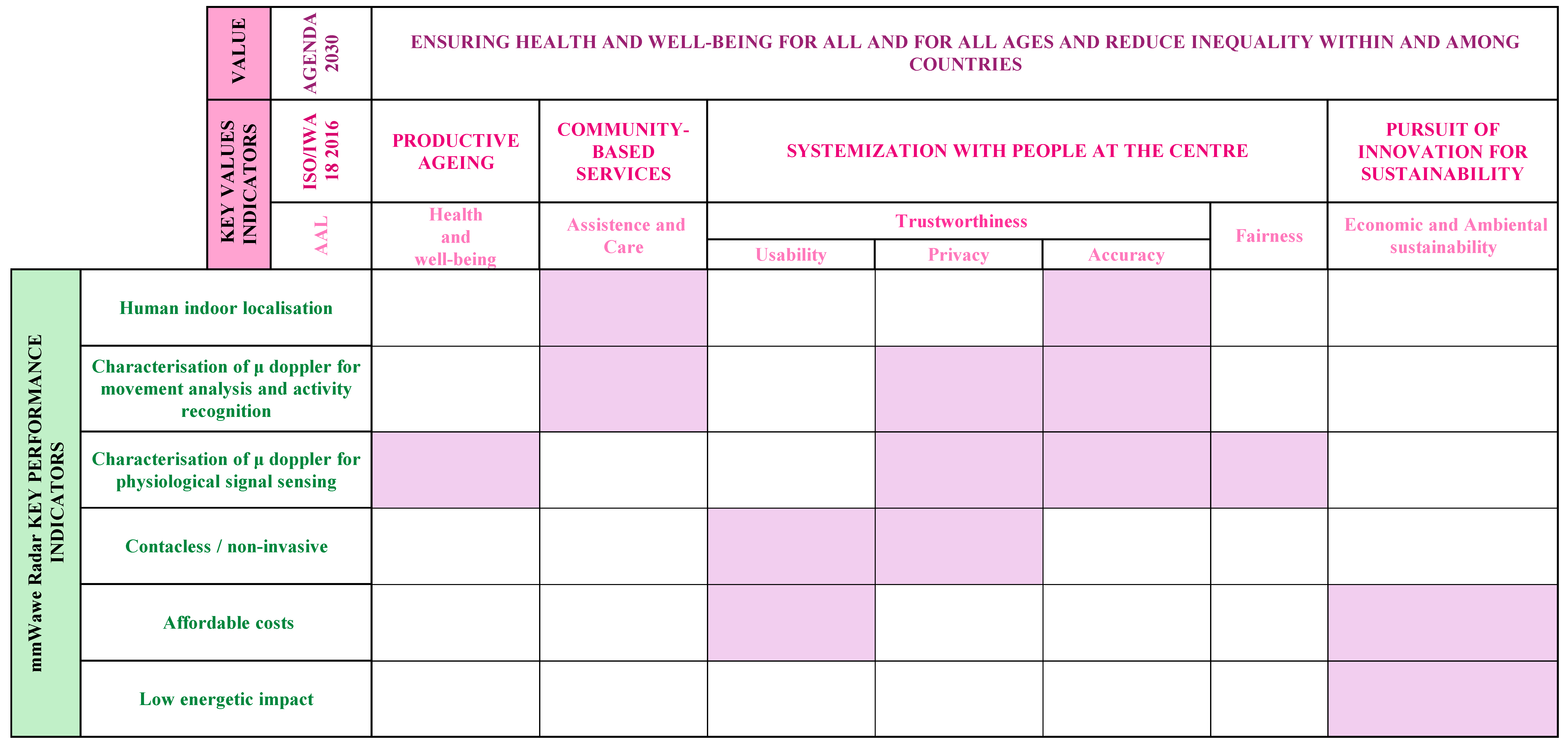
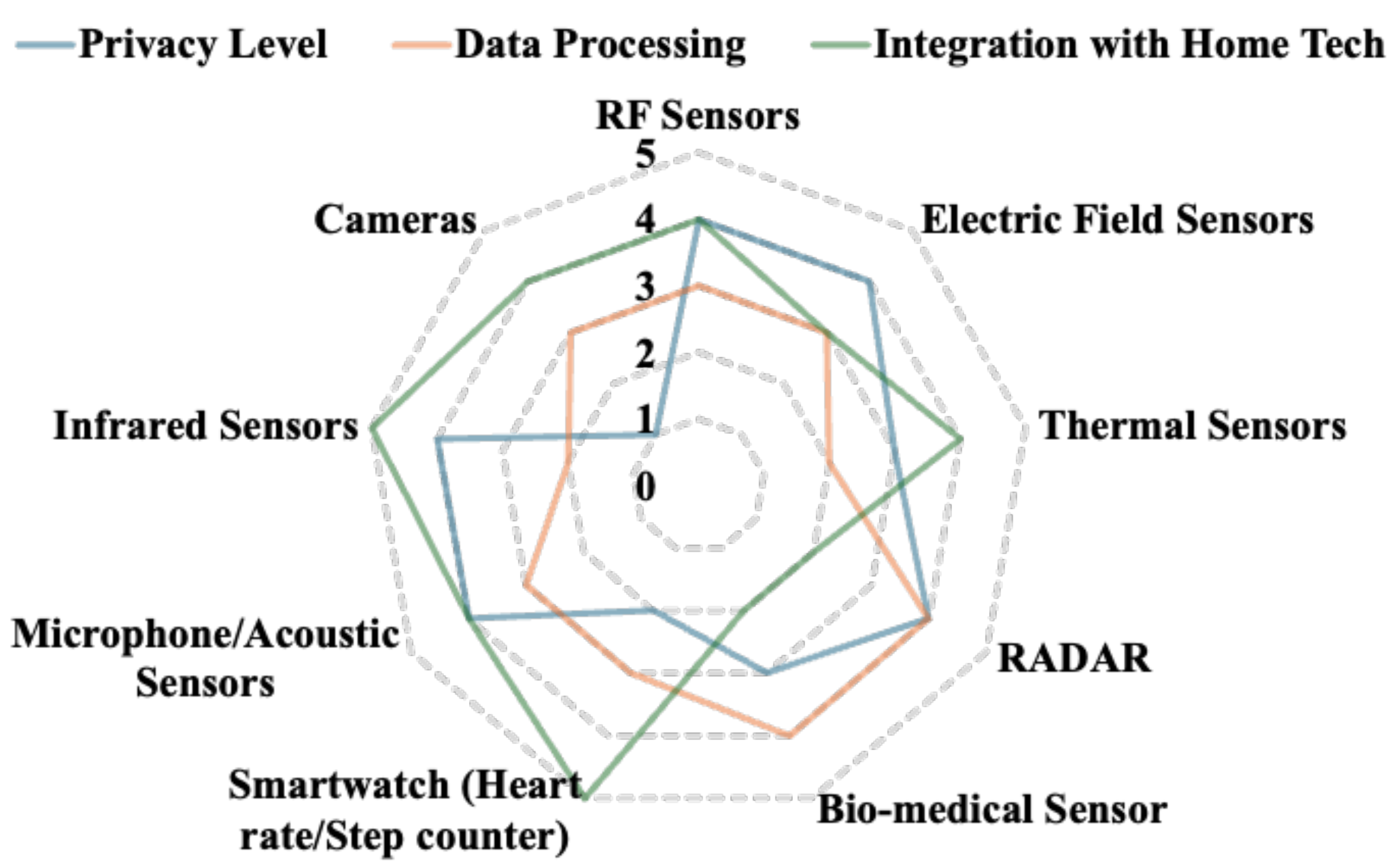
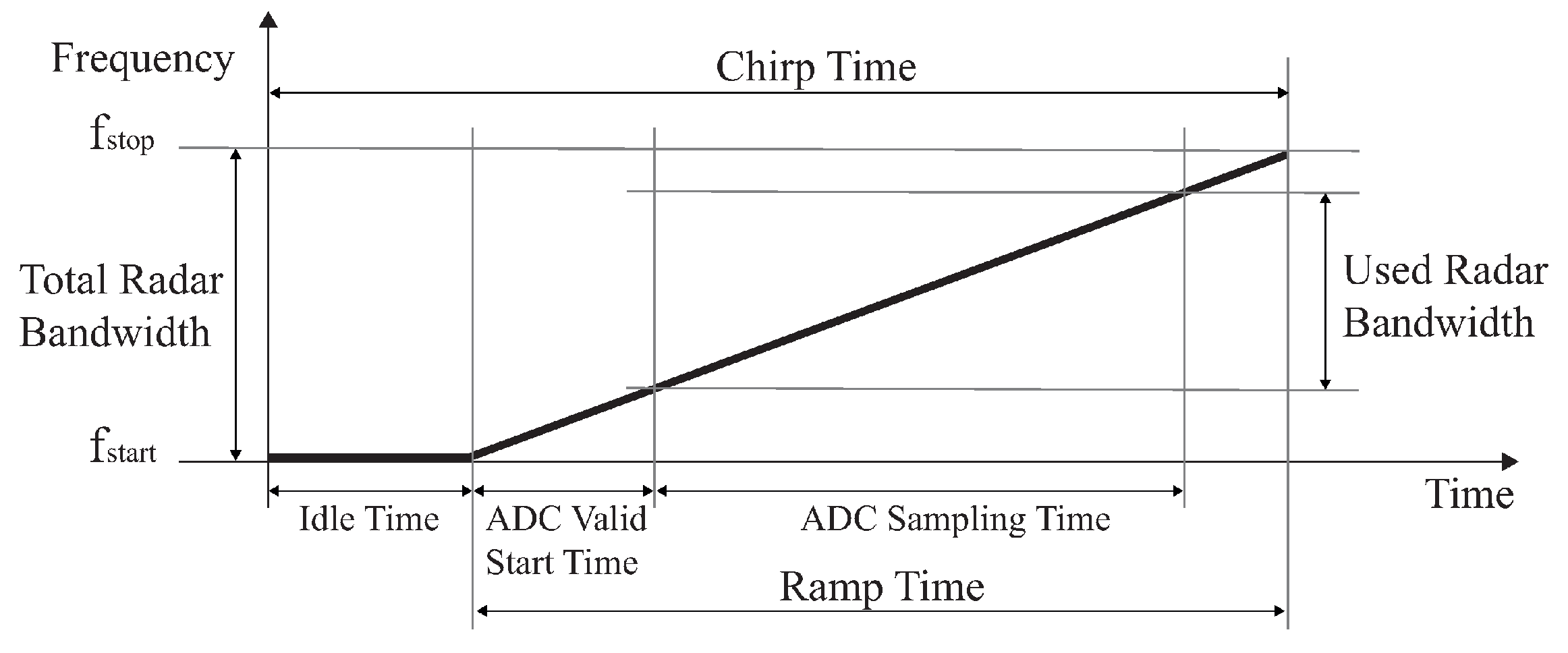
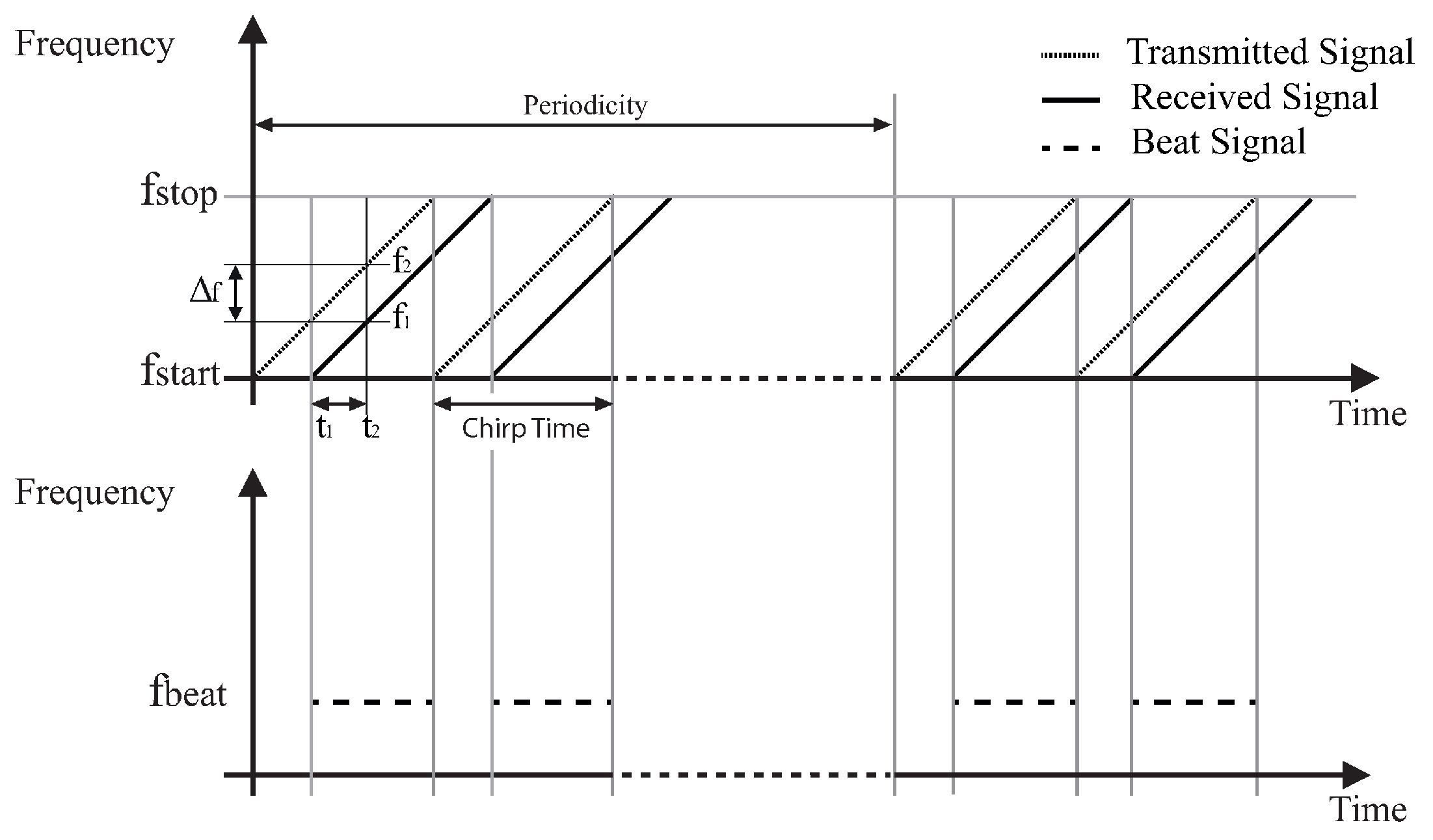
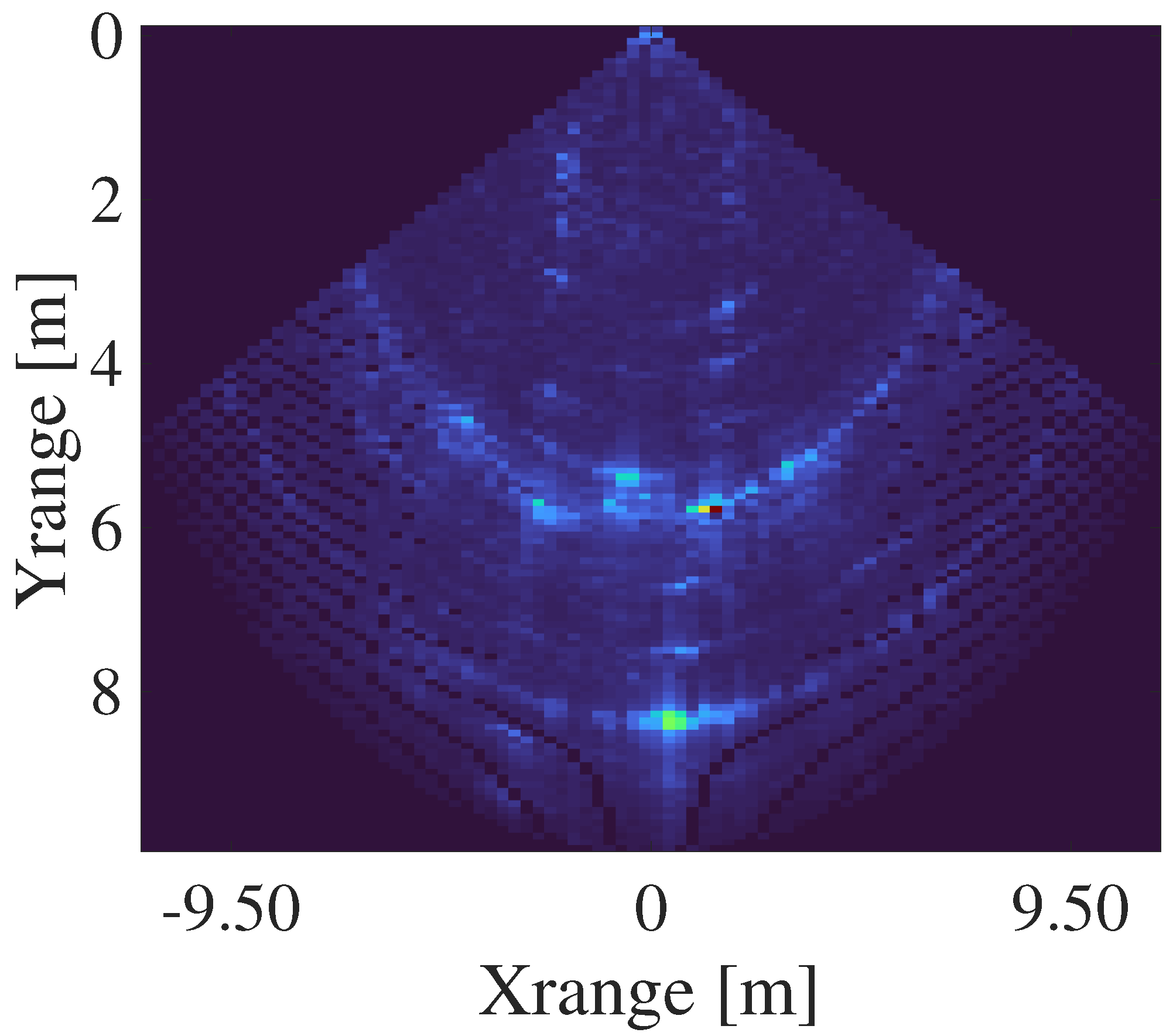
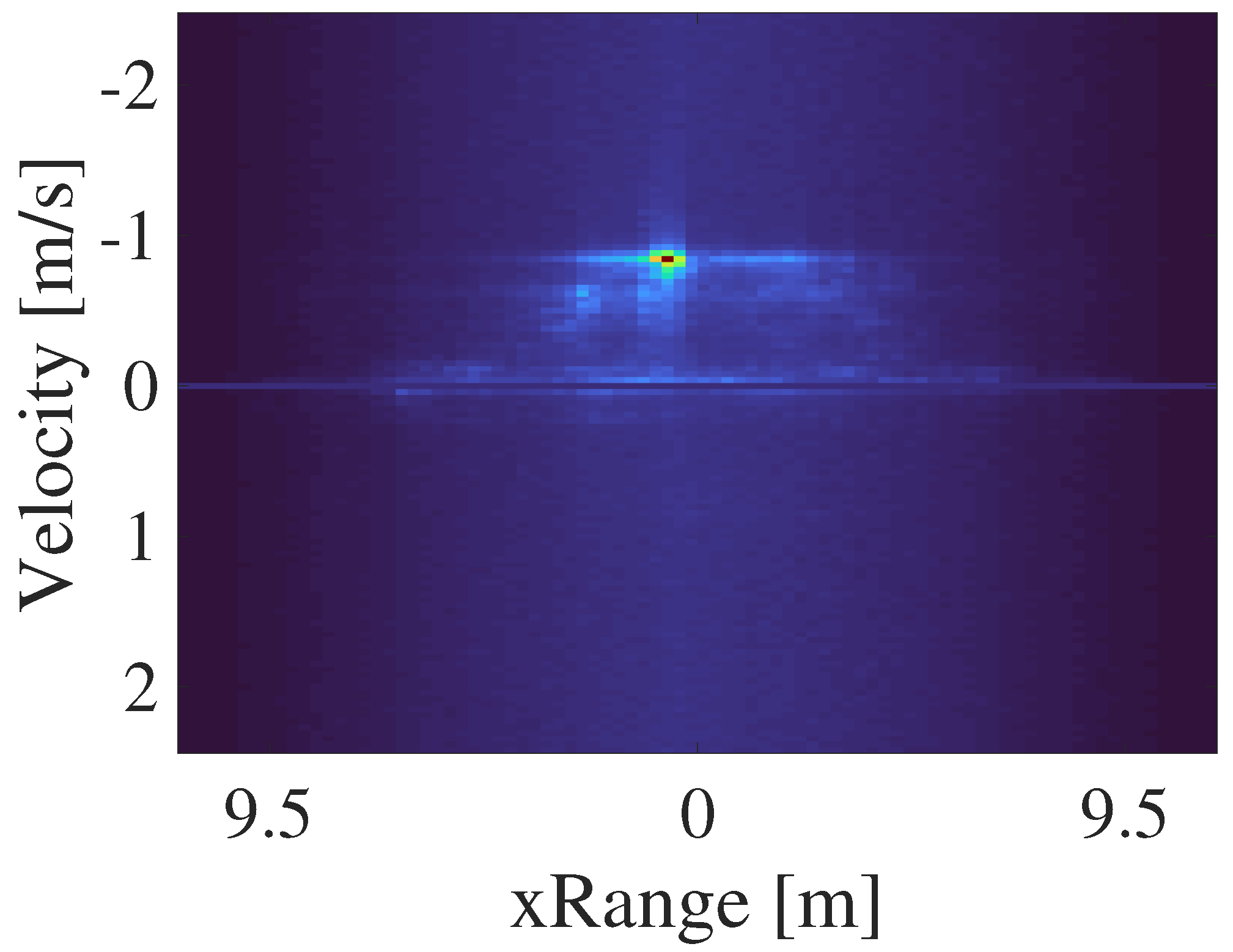

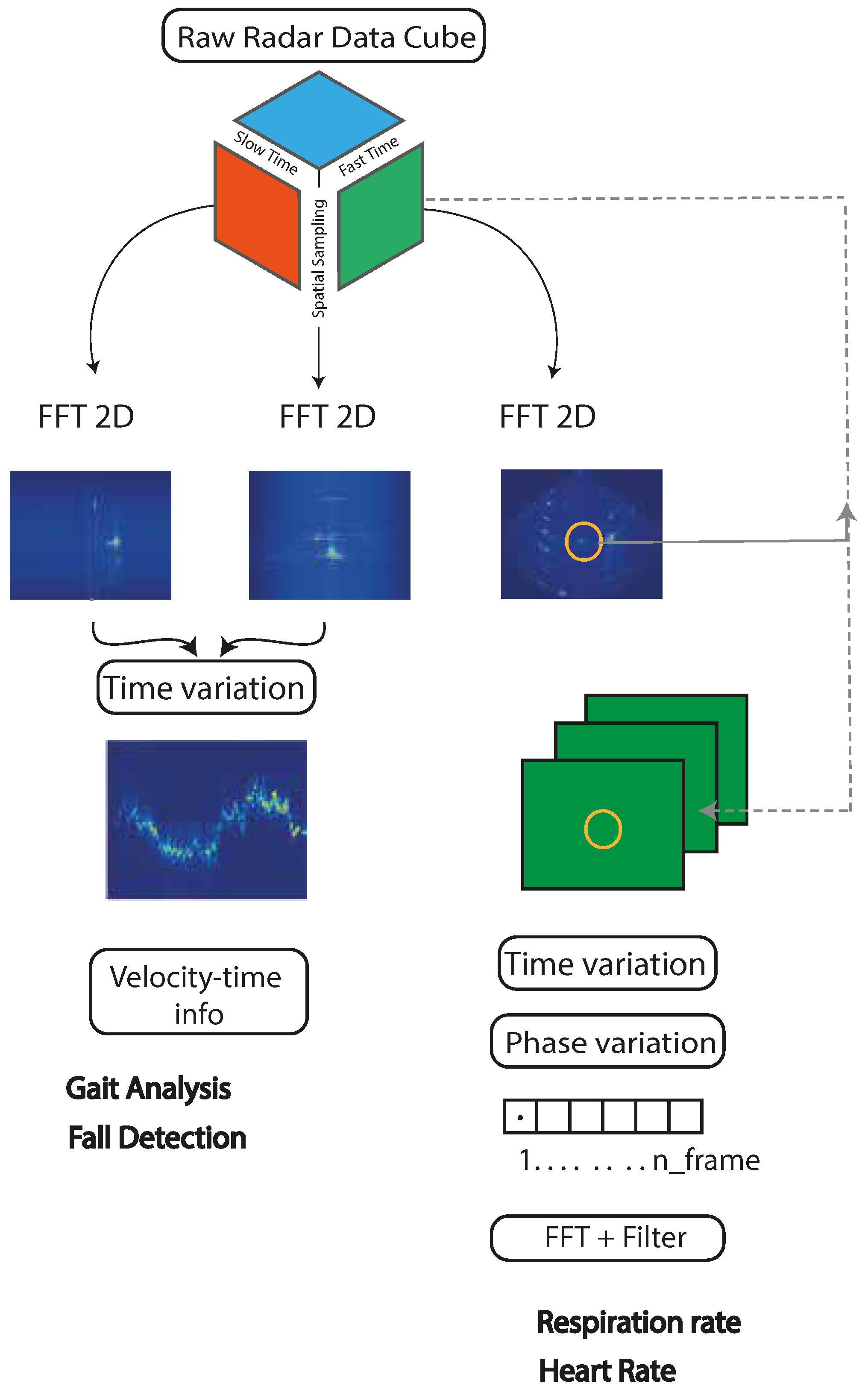
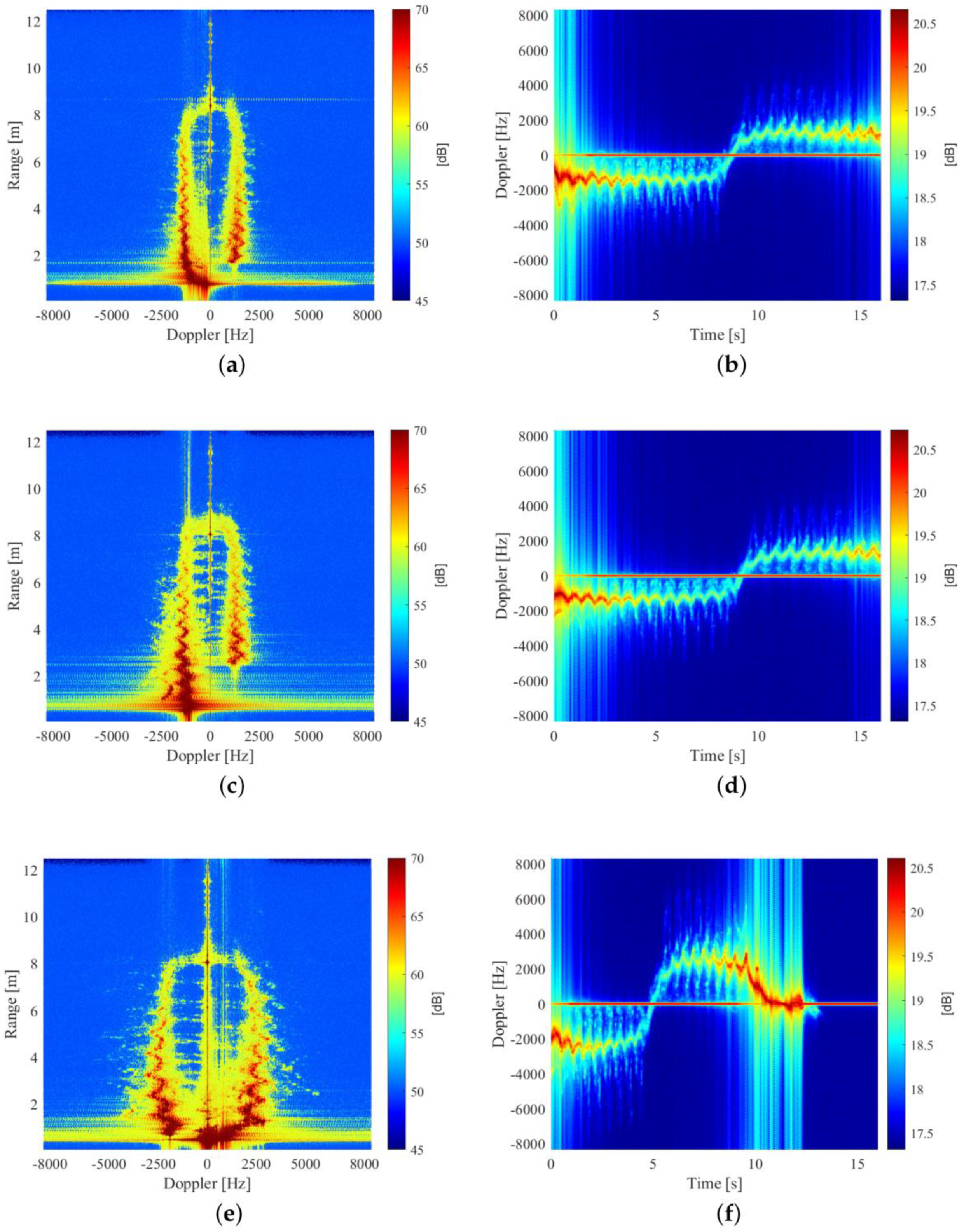
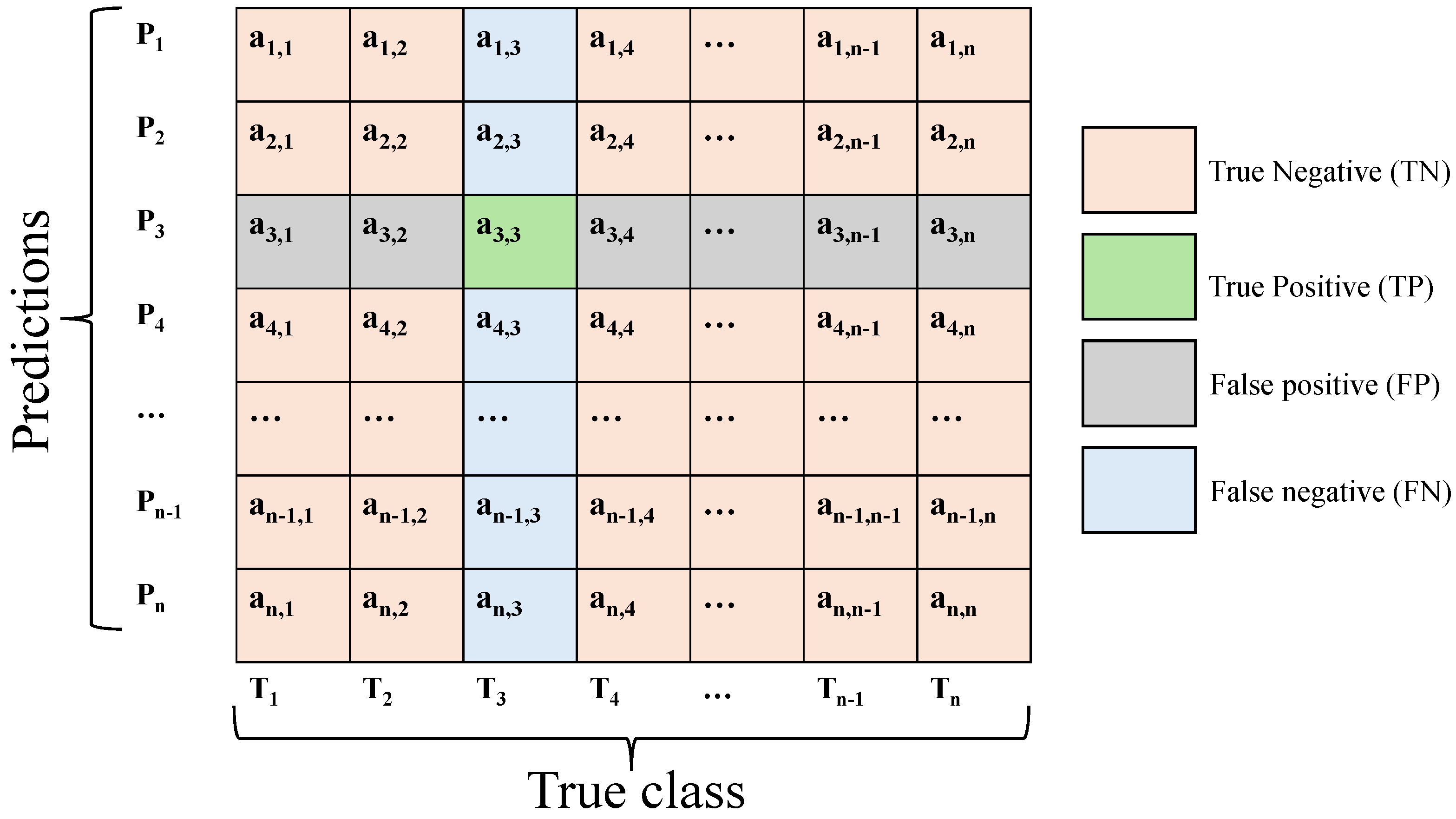
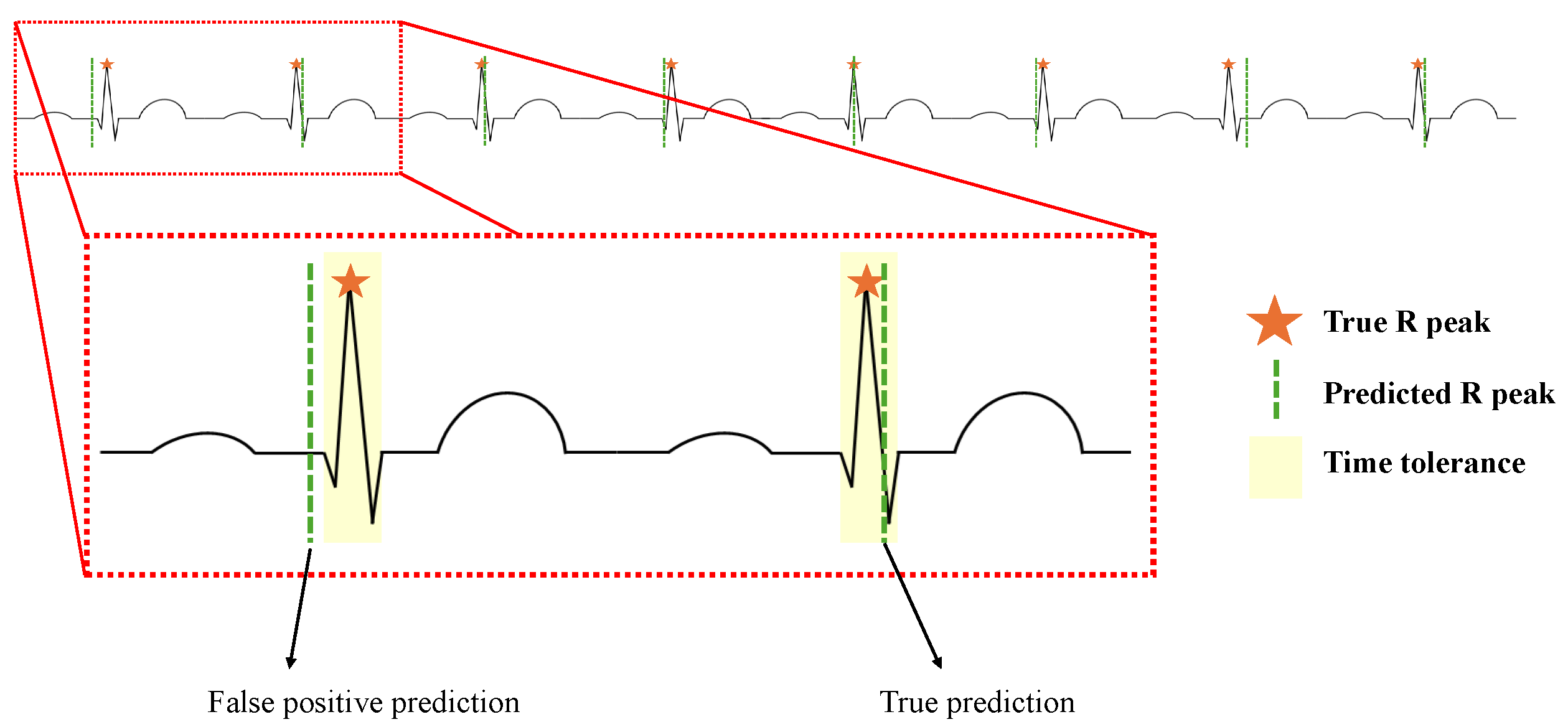
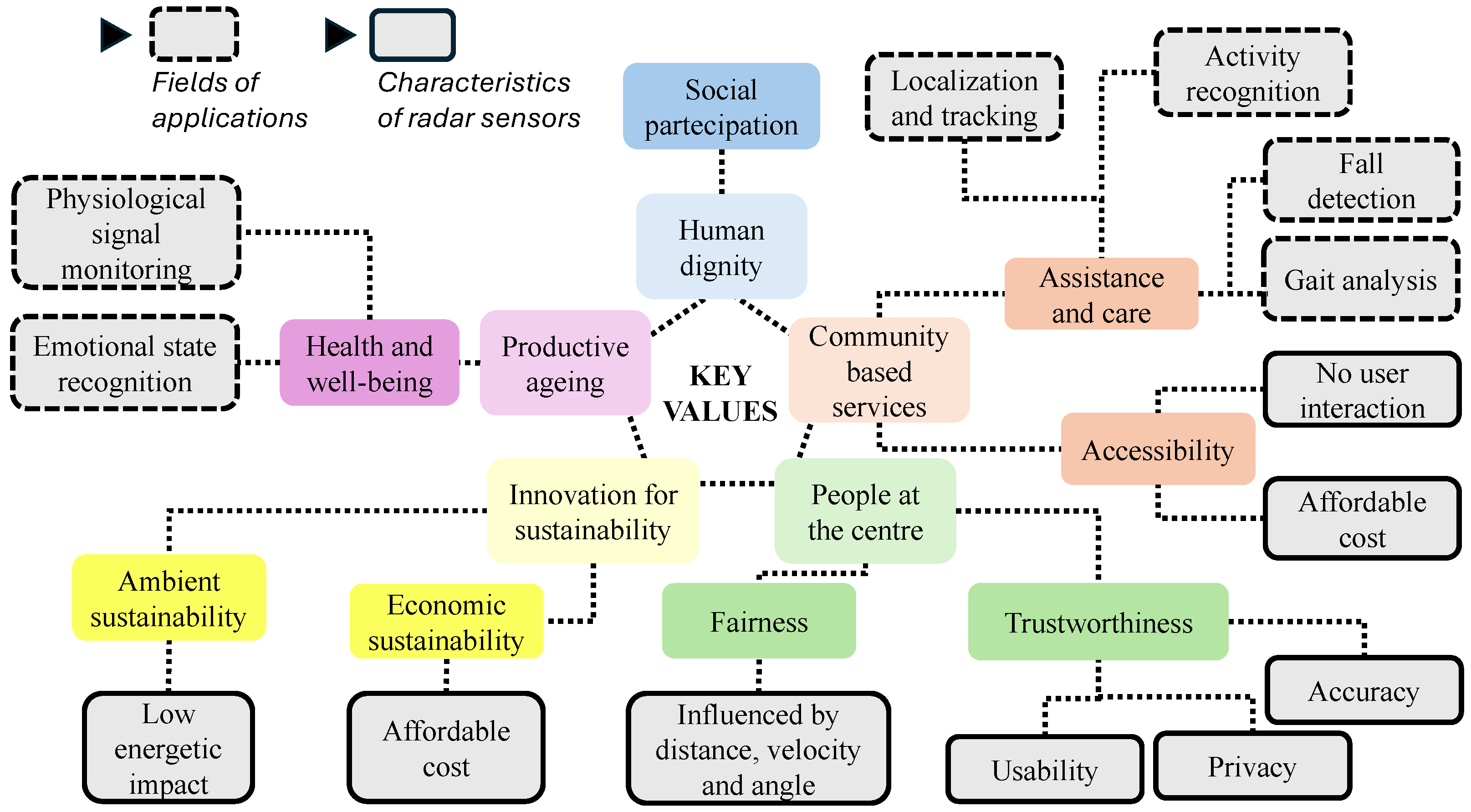
| KVI Theme | Radar KVI Examples | ISO 9001:2015 Clause | Implementation via ISO Procedure |
|---|---|---|---|
| Productive Aging and Community-Based Services | Fall detection accuracy, gait analysis, vital signs monitoring | 88.1, 8.2 (Operational planning and service requirements); 9.1 (Performance evaluation) | Service design and planning; measurement of outcomes and satisfaction |
| Usability, Privacy, Fairness, Accuracy | Non-imaging sensing, low false positives, high detection precision, novel micro-Doppler analytics | 4.4 (System approach/PDCA), 5.1/5.2 (Leadership commitment to policy) 9.1.3; 10.2 (Nonconformity and corrective); 6.2/6.3 (Objectives and planning); 10.3 (Continual improvement) | Leadership commitment; defined objectives (accuracy, privacy); root cause and corrective action processes, Setting innovation goals; system-based management; continuous improvement through PDCA, harvest data for improvement |
| Economic and Environmental Sustainability | Cost-effective components, low energy use, modular scalability, low-power designs, eco-sourcing | 6.1 (Risk and opportunity), 7.1.3 (Infrastructure and environment), 10.3(Improvement for suitability/adequacy) | Risk and opportunity analysis/management; efficient infrastructure; sustainable development planning |
| Central Frequency | Max Range | Depth Sensing Technology | Advantages | Disadvantages | |
|---|---|---|---|---|---|
| Radar FMCW | Ghz | 150 m | Frequency modulation and signal processing | robustness to environmental changes, direct evaluation of velocity with Doppler shift | low angular resolution and small interpretability of the maps |
| Lidar | kHz | 50-100 m | Time of flight sensor | high angular resolutions, point cloud visualisation | no information related to velocity |
| Depth Camera | Thz | 10 m | Time of flight, light patterns or stereoscopy | high angular resolution, point cloud visualisation | limited range, no information related to velocity |
Disclaimer/Publisher’s Note: The statements, opinions and data contained in all publications are solely those of the individual author(s) and contributor(s) and not of MDPI and/or the editor(s). MDPI and/or the editor(s) disclaim responsibility for any injury to people or property resulting from any ideas, methods, instructions or products referred to in the content. |
© 2025 by the authors. Licensee MDPI, Basel, Switzerland. This article is an open access article distributed under the terms and conditions of the Creative Commons Attribution (CC BY) license (https://creativecommons.org/licenses/by/4.0/).
Share and Cite
Gardano, M.; Nocera, A.; Raimondi, M.; Senigagliesi, L.; Gambi, E. A Narrative Review on Key Values Indicators of Millimeter Wave Radars for Ambient Assisted Living. Electronics 2025, 14, 2664. https://doi.org/10.3390/electronics14132664
Gardano M, Nocera A, Raimondi M, Senigagliesi L, Gambi E. A Narrative Review on Key Values Indicators of Millimeter Wave Radars for Ambient Assisted Living. Electronics. 2025; 14(13):2664. https://doi.org/10.3390/electronics14132664
Chicago/Turabian StyleGardano, Maria, Antonio Nocera, Michela Raimondi, Linda Senigagliesi, and Ennio Gambi. 2025. "A Narrative Review on Key Values Indicators of Millimeter Wave Radars for Ambient Assisted Living" Electronics 14, no. 13: 2664. https://doi.org/10.3390/electronics14132664
APA StyleGardano, M., Nocera, A., Raimondi, M., Senigagliesi, L., & Gambi, E. (2025). A Narrative Review on Key Values Indicators of Millimeter Wave Radars for Ambient Assisted Living. Electronics, 14(13), 2664. https://doi.org/10.3390/electronics14132664








